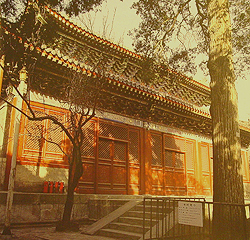 The Cypress Grove Temple is situated in the northeastern part of Beijing?s East City District immediately of the east of the Yonghe Lamasery.
The Cypress Grove Temple is situated in the northeastern part of Beijing?s East City District immediately of the east of the Yonghe Lamasery.
When first built in 1347 during the Yuan Dynasty, the temple was one of the largest Buddhist temples in Dadu. It underwent repair and renovation three times during the Ming and Qing dynasties, the largest of these projects being carried out in 1712 during the reign of Emperor Kangxi, when his son Prince Yinzhen ordered the work to be carried out to commemorate his father?s 60th birthday.
The five main structures in the temple compound are laid out on a central axis. Proceeding from the front gate to the rear of the temple, they are as follows: the main gate, the Devaraja Hall (Hall of the Heavenly Kings), the Hall of Attaining Perfection (Yuanjuxingjuedian), the Mahavira Hall (Daxiongbaodian) and the Vimalakirti Hall or Hall of Bodhisattva Purity (Weimoge).
A horizontally inscribed plaque in the handwriting of Emperor Kangxi which reads ?The Everlasting Cypress Grove? (Wangubailin) hangs on the fa?ade of the Mahavira Hall, while statues of the Buddhas of the Three Worlds are found inside. Behind this hall is the Hall of Vimalakirti, containing seven carved and gilded Buddha images dating from the Ming Dynasty.
To the east of the main hall is an auxiliary hall containing two large bronze bells 2.6 metes tall cast in 1707. Their surfaces were cast with bas-reliefs of coiling dragons and the texts of incantations (mantras) intoned after a person?s death in the hope of gaining passage to the Pure Land.
Among the valuable relics in the temple is a complete set of printing blocks for the Tripitaka (the complete corpus of Buddhist sutras) carved in the early 18th century. The collection has 7,240 volumes with a total of 78,230 separate blocks. Carved of high-grade pear wood, the blocks remain in fine condition today except for some minor cracks. The work of carving took six years to complete and was begun in 1733 during the reign of Emperor Yongzheng. However, fewer than 200 copies of the Tripitaka were printed during the ensuing 300 years, one reason why the blocks remain in excellent condition.
The blocks were originally stored in the Hall of Military Prowess (Wuyingdian) in the Palace Museum, but were later transferred back to the temple. They are presently being cared for under the supervision of the Beijing Library.
Address: No.1 Xilou Hutong, Dongcheng District.
(china.org.cn April 24, 2003)
|

